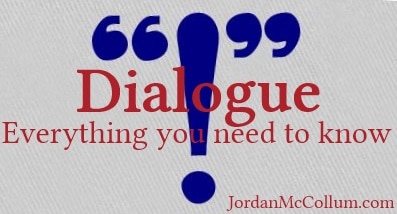Dialogue. In many scenes, it’s the lifeblood of conflict, relationships, tension—fiction! Is your dialogue the best it can be?
Other news: want to participate in the blog tour for Spy Noon, or just get a review copy? Sign up here!
The punctuation
 We’ll start with the technical stuff—a little rote memorization and it’s easy to master. Punctuating dialogue can be tricky—but messing it up (aside from the occasional error) will mark you as an amateur.
We’ll start with the technical stuff—a little rote memorization and it’s easy to master. Punctuating dialogue can be tricky—but messing it up (aside from the occasional error) will mark you as an amateur.
There are thirteen things wrong with the punctuation, paragraphing and capitalization in this passage. Can you catch them all?
“I can’t do this.” She said.
“But you have to,” he rubbed his hands together. “Really?,” She asked.
He nodded, “really, truly, Johnny Lion.”
“But—.”
“No buts. I know—,” he glanced around furtively, “I know you can do it.”
Need a quick refresher on dialogue mechanics? Check out #6 on this list of dialogue basics!
Non-dialogue: the rest of the story
When writing dialogue, we need to balance our narrative with the dialogue, and use that narrative to make it clear who’s speaking, show how they’re saying these things, increase the tension, ground the reader in a setting (instead of using “talking heads”), and more.
Again, balancing dialogue with narrative can be difficult. That’s why I made a happy little flow chart on how to attribute speech in fiction!
Those verbs!
All of us had the same teachers drumming the same rot into our brains: that it’s better to use a variety of speech verbs, so rather than ever repeat “said,” it’s better to hit up the thesaurus for postulated, pointed out and prevaricated.
But when you come across those—or even just too many of those—in a book, they tend to stand out. The good old standby, “said,” tends to blend right in, almost invisible to the reader’s eye because we’re so used to seeing it. It’s one of the first sight words kids are taught today in learning to read, because knowing that word opens up a world of understanding.
Of course, even said can be annoying if it’s repeated too much.
At the other end of the spectrum, we find another problem: inappropriate speech verbs. Go to the mirror (or turn on your webcam). Smile at yourself. Now, try to talk while maintaining that smile. Sounds a little funny, eh? Try it while laughing. Try “hissing out” a line of dialogue without a single sibilant (s, sh, z).
When we use a verb as an attribution, we need to make sure that verb is a speech verb (and an appropriate one ;)) . Need help? Learn to stop “smiling” dialogue.
The delicate balance: pseudorealism
For the most part, we try to write realistic fiction. We want our people to act and think and sound like real people living in the real world. Except that our fictional people have to make a whole lot more sense than the people in the world around us, or we’ll lose our audience (even if they’d act the exact same way in real life).
So it is with dialogue. We have to emulate real conversations, but we can’t slavishly follow the real way people would speak, or we’ll be reading a whole lot of “uh, like, you know, and, uh,” nonsensical elliptical references and people responding to the first half of what you said, but not the rest because they stopped listening to think of their answer.
Seriously: go eavesdrop on a casual conversation or tape record your dinner chats. If you transcribed that, it would either be boring, impossible to follow or just utterly unrealistic.
Struggling with this balance? You can learn to make your dialogue more realistic—or go for more fictionally appropriate dialogue.
Dialogue needs to do something
Part of the problem with that utterly boring dialogue we recorded at dinner is that we lack a goal in our conversations (beyond the relationship/conversation). In fiction, we need to remain goal-oriented. We don’t have to include every second of our characters’ lives from the time they wake up until they climb back between the covers at night—we focus on the parts of their lives that move our story forward.
We need to do the same with our characters’ conversations: enter late and exit early for maximum effect. But more than that, we as authors must be clear what the purpose of this conversation is. What does our character expect to get out of this communication? An answer, a friend, some help? Will they attain their goal? Will the other people in the dialogue help or hinder?
Dialogue accomplishes story purposes for sure, but if that’s all we use our dialogue for, it’ll probably ring pretty flat. Dialogue should be a way to indirectly show your characters: what they say, how they say it. Every passage of dialogue should be working on multiple levels to move your story forward, make it richer and deeper, and show your characters. (More purposes of dialogue from Annette Lyon.)
Also important: what they’re not saying. Subtext is one technique I consider more advanced in dialogue and storytelling. The basic definition is an element that carries a second level of meaning. A symbol might be considered a type of subtext.
In dialogue, it’s when a character says one thing, but the reader can infer another layer of meaning. Maybe the character doth protest too much; maybe his gestures show her anger despite his reassurances that he’s okay; maybe the reader knows this character acts like he’s the one when she’s with her friends, but plays hard to get when he’s around.
Need to brush up on subtext? Four ways to convey a deeper meaning.
More on dialogue
- Adding tension to dialogue (or during kind of boring dialogue)
- Revealing backstory through dialogue
- At the other extreme: find info dumps in dialogue and fix info dumps in dialogue.
What are your best dialogue tips?


